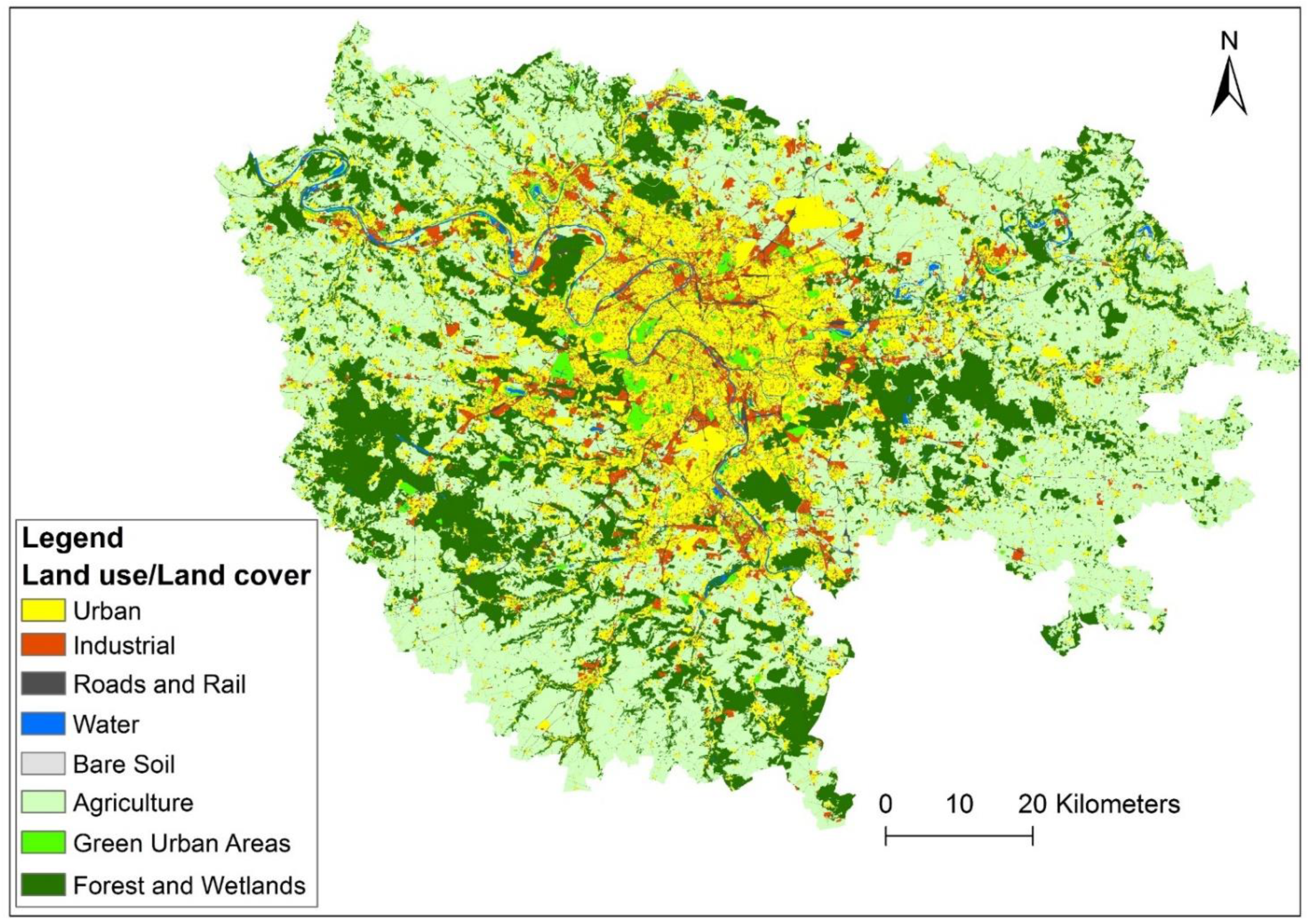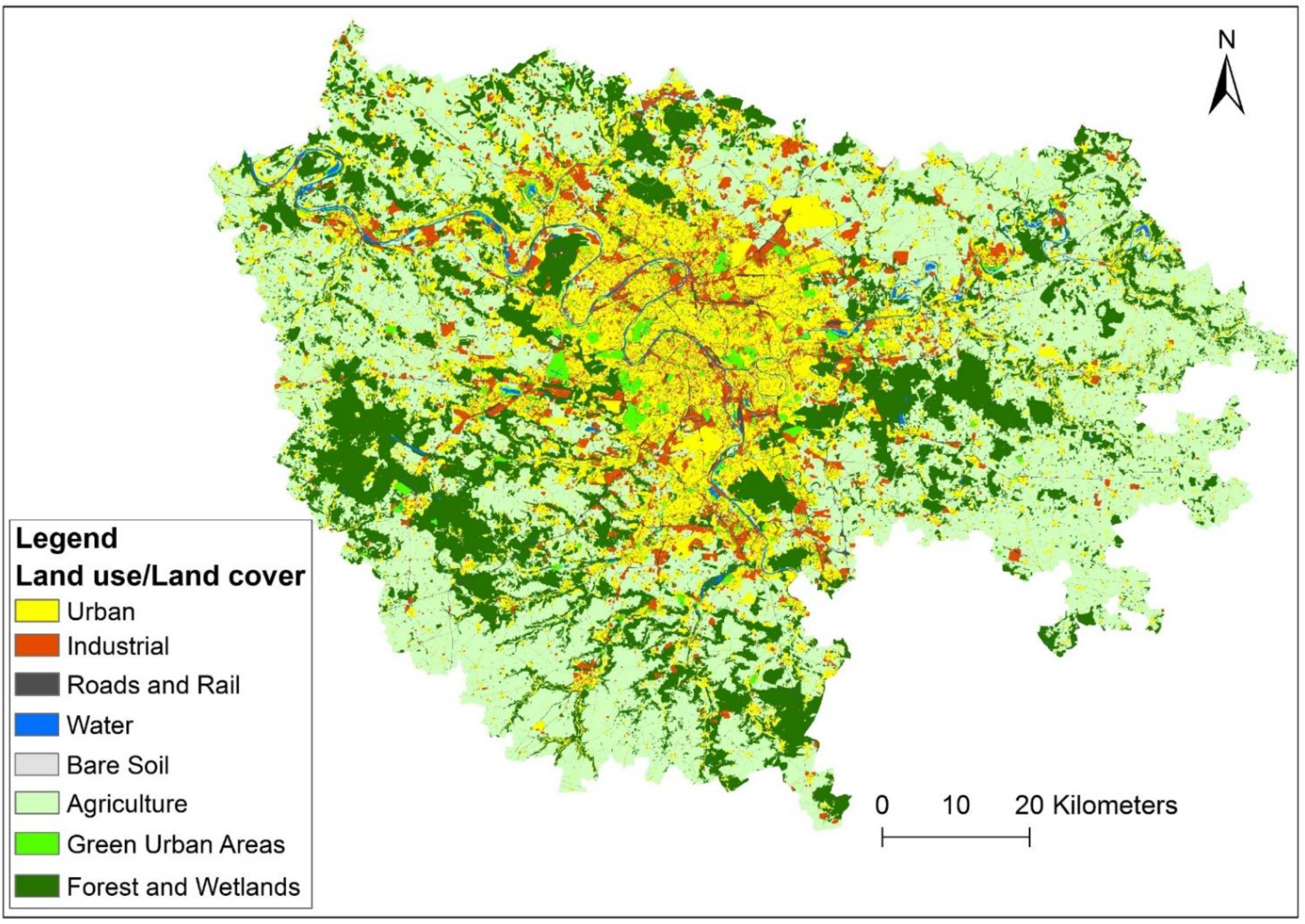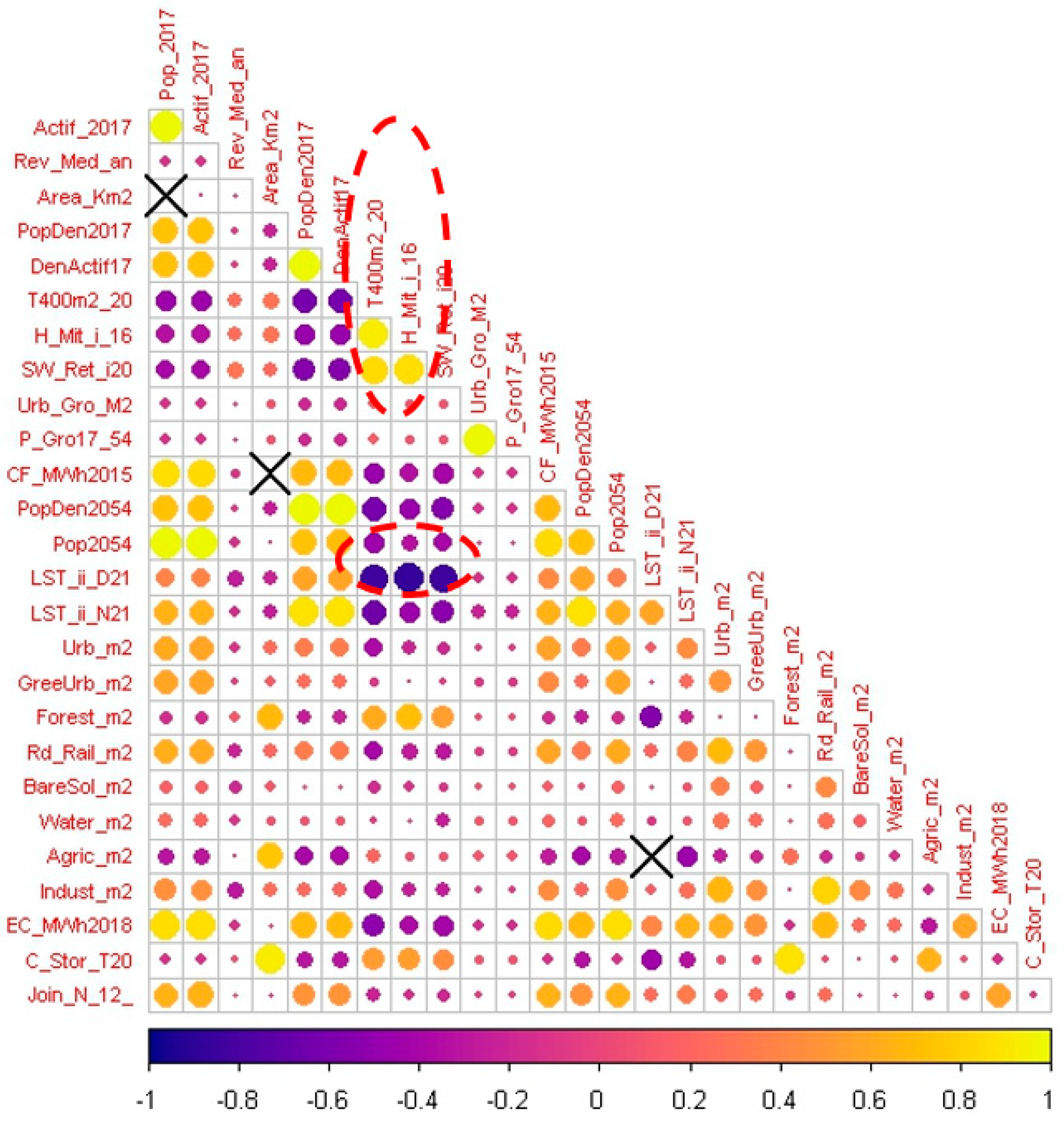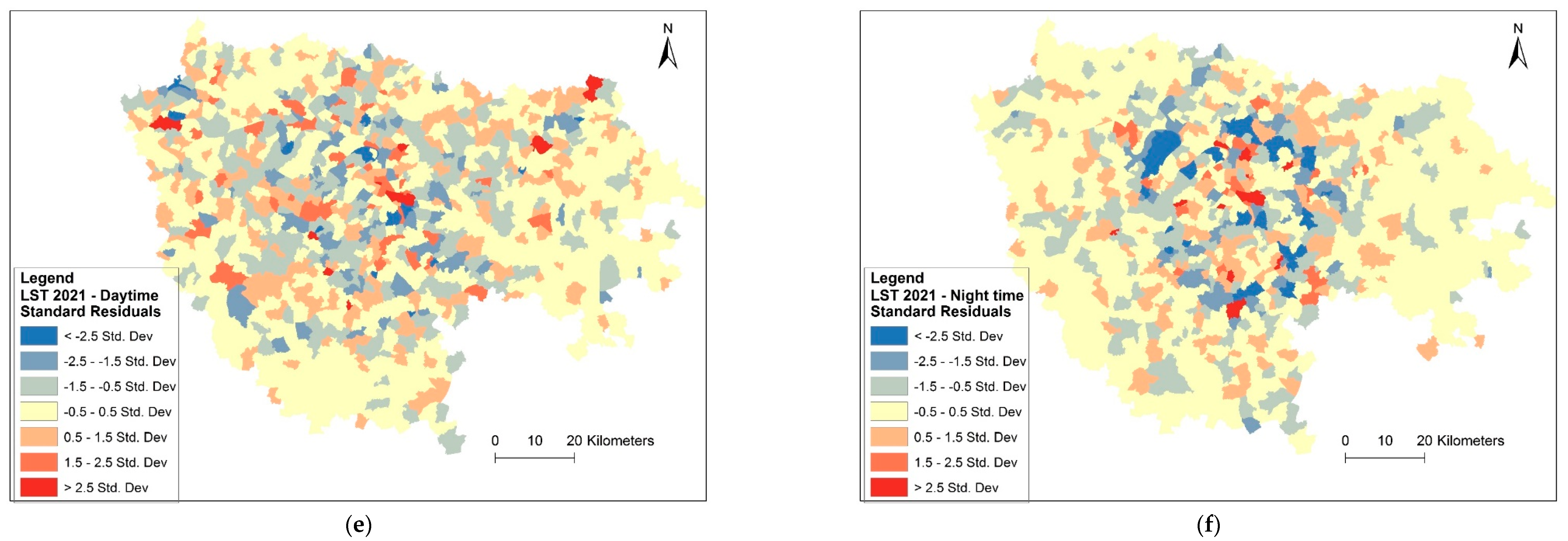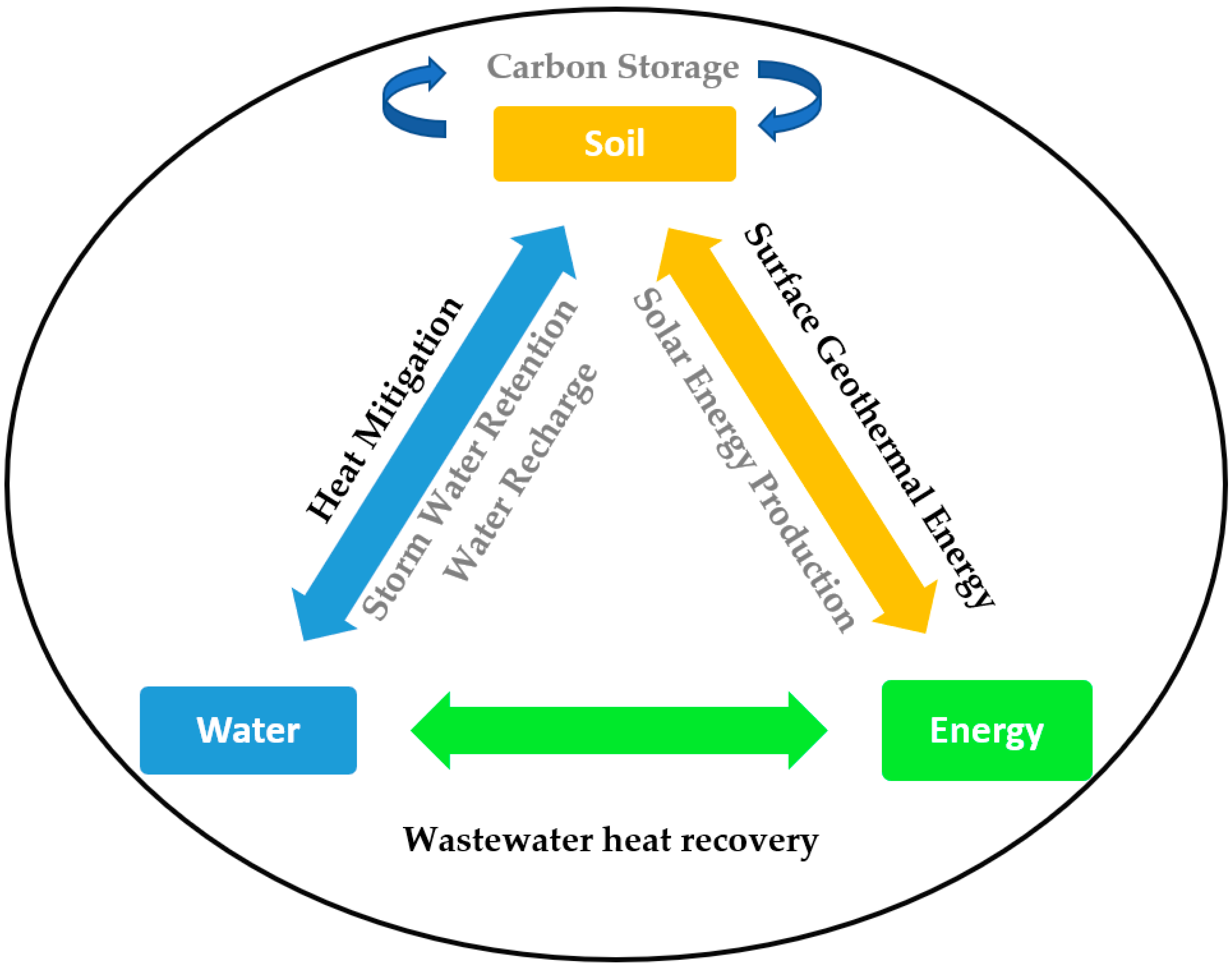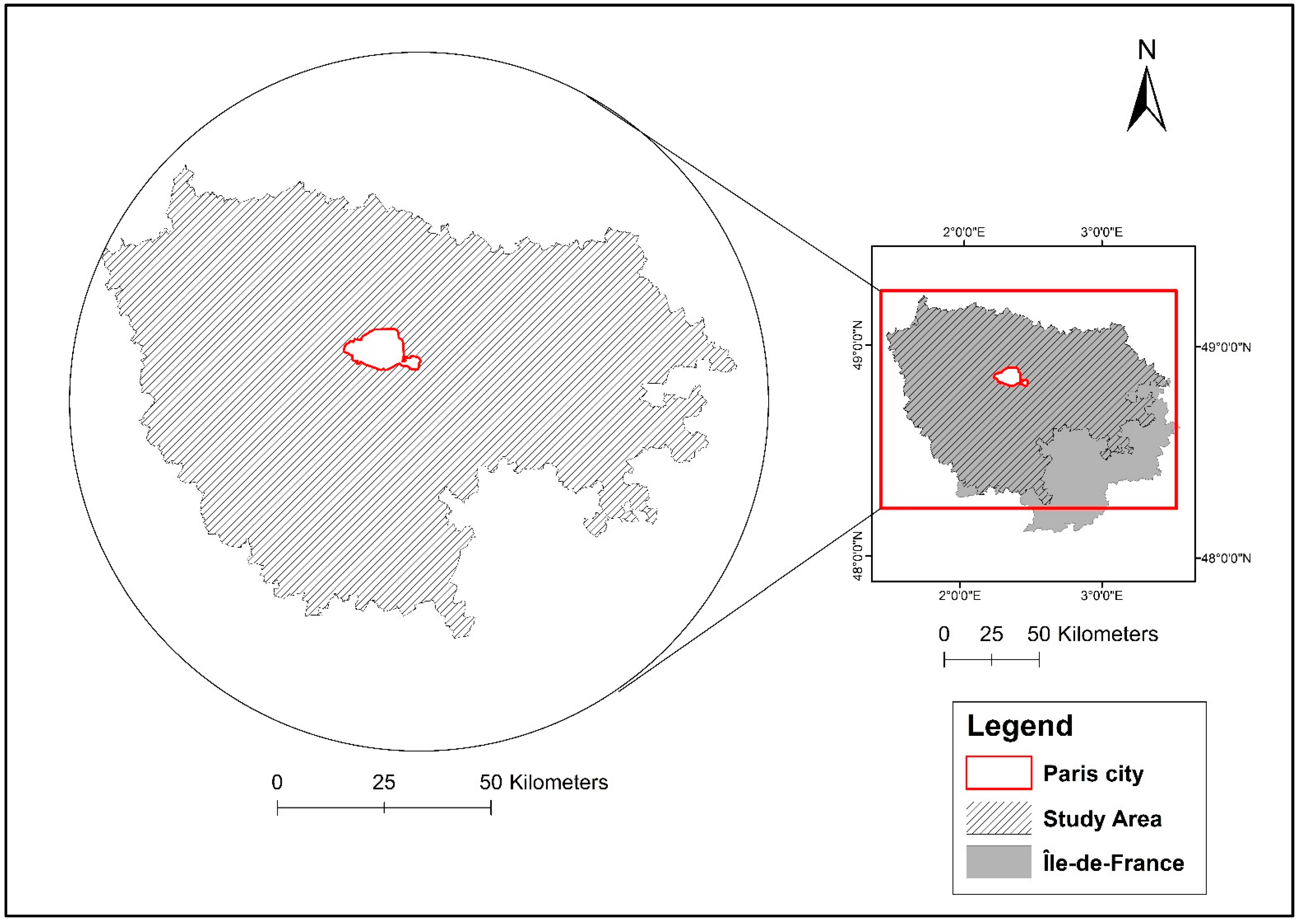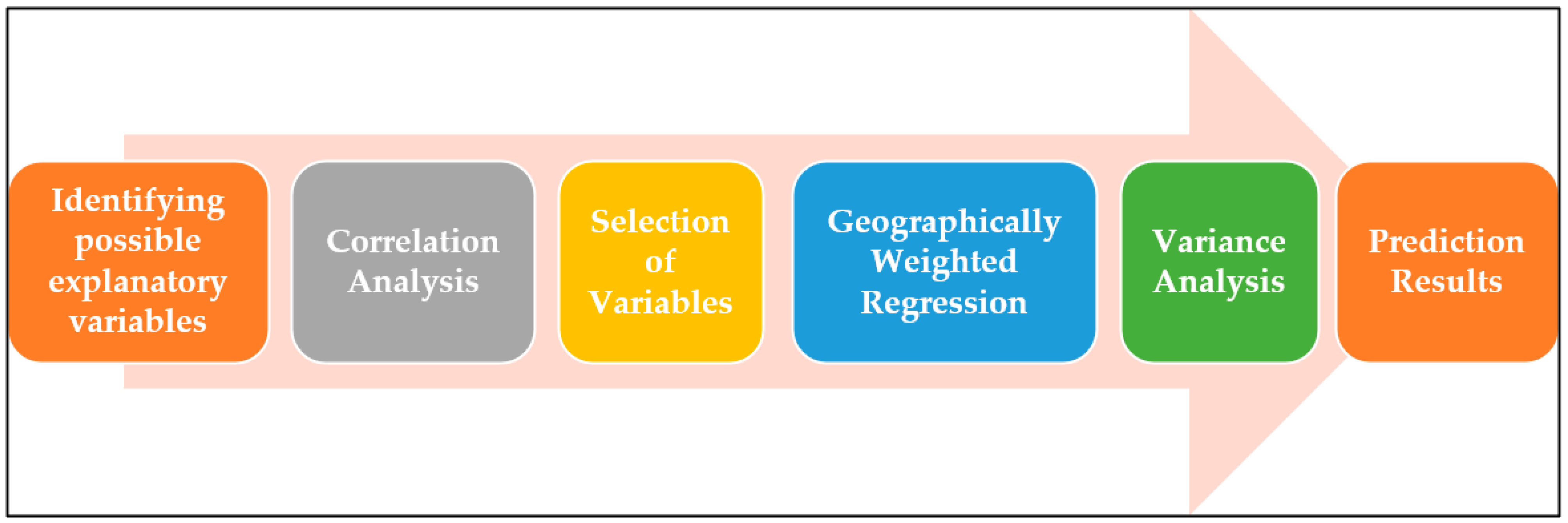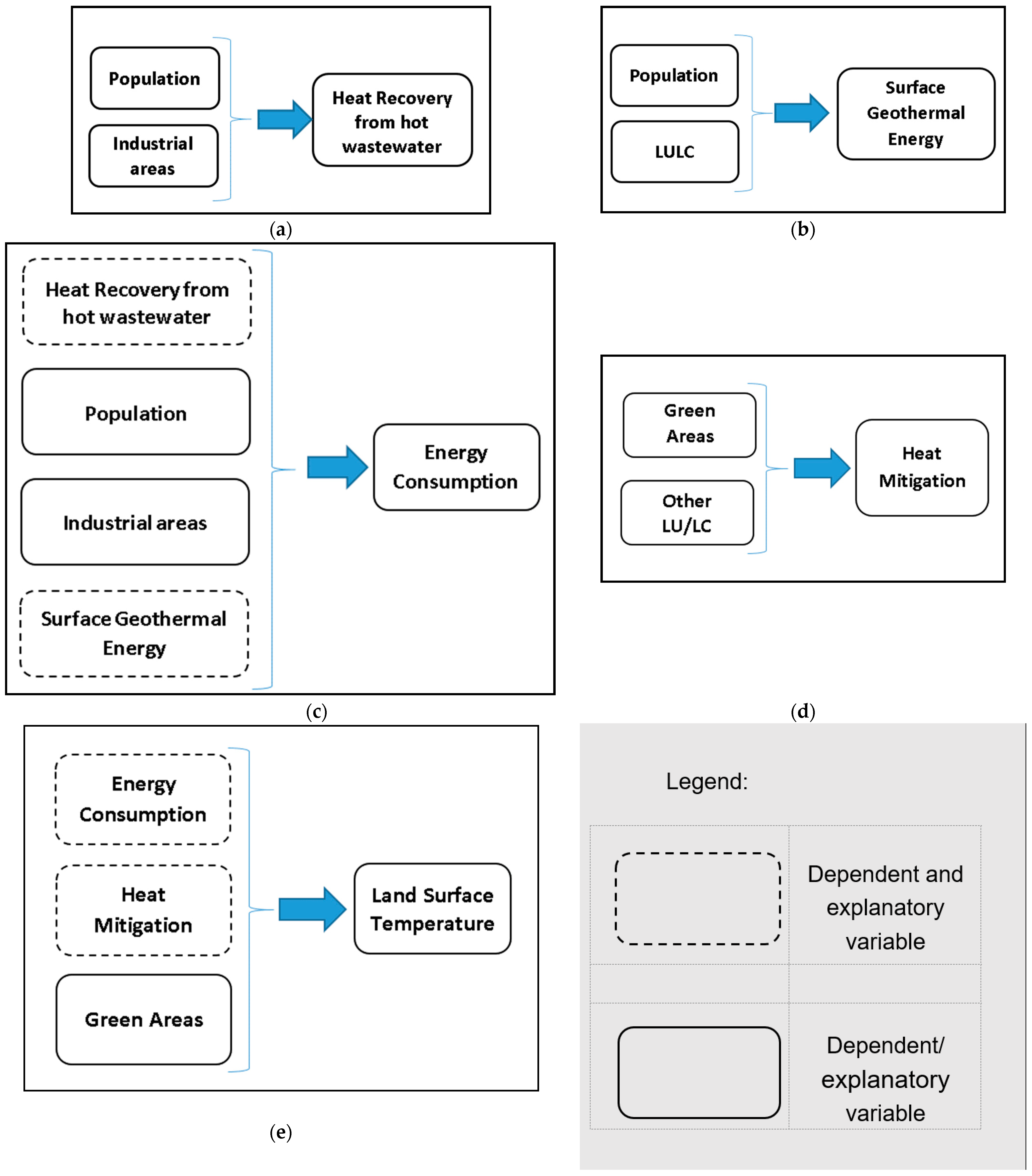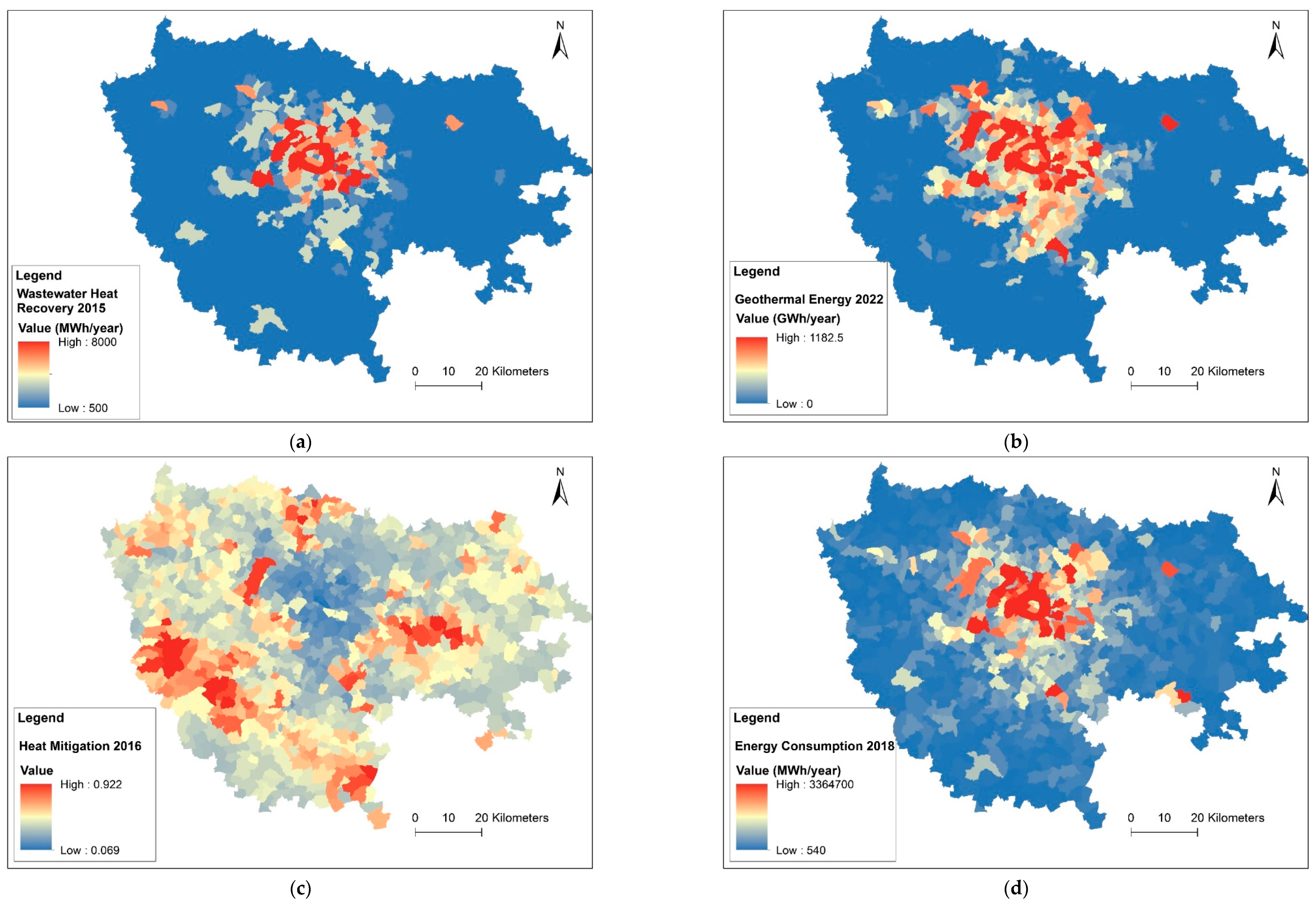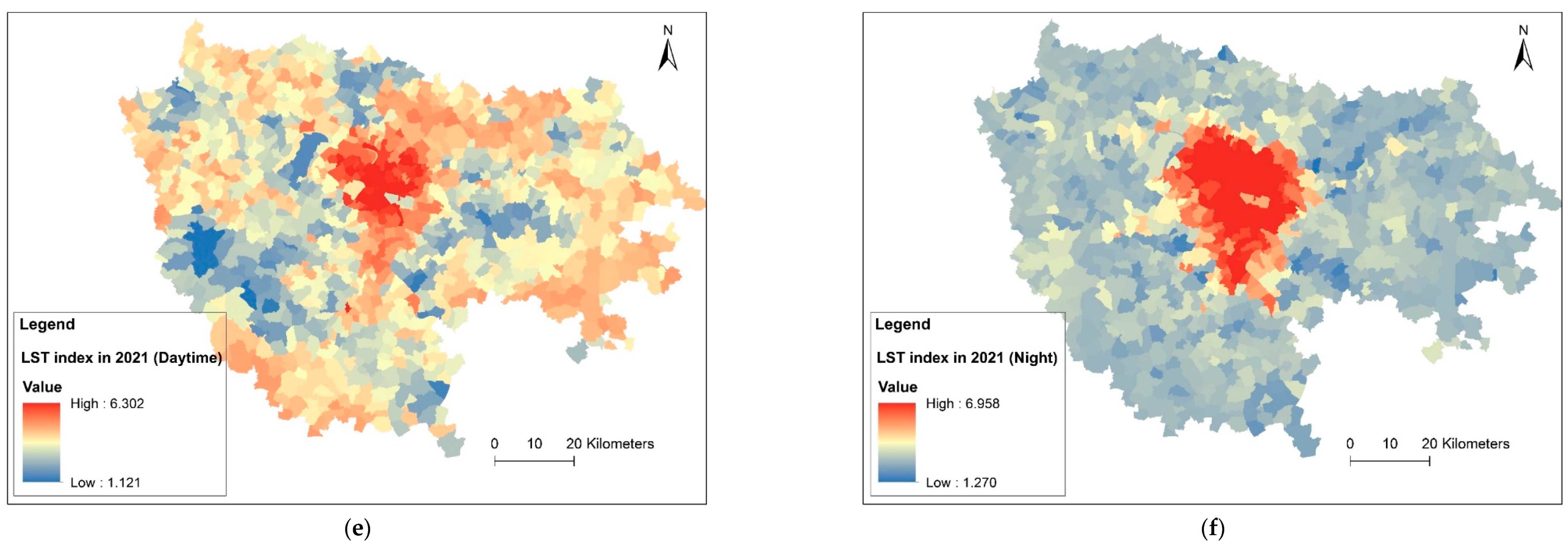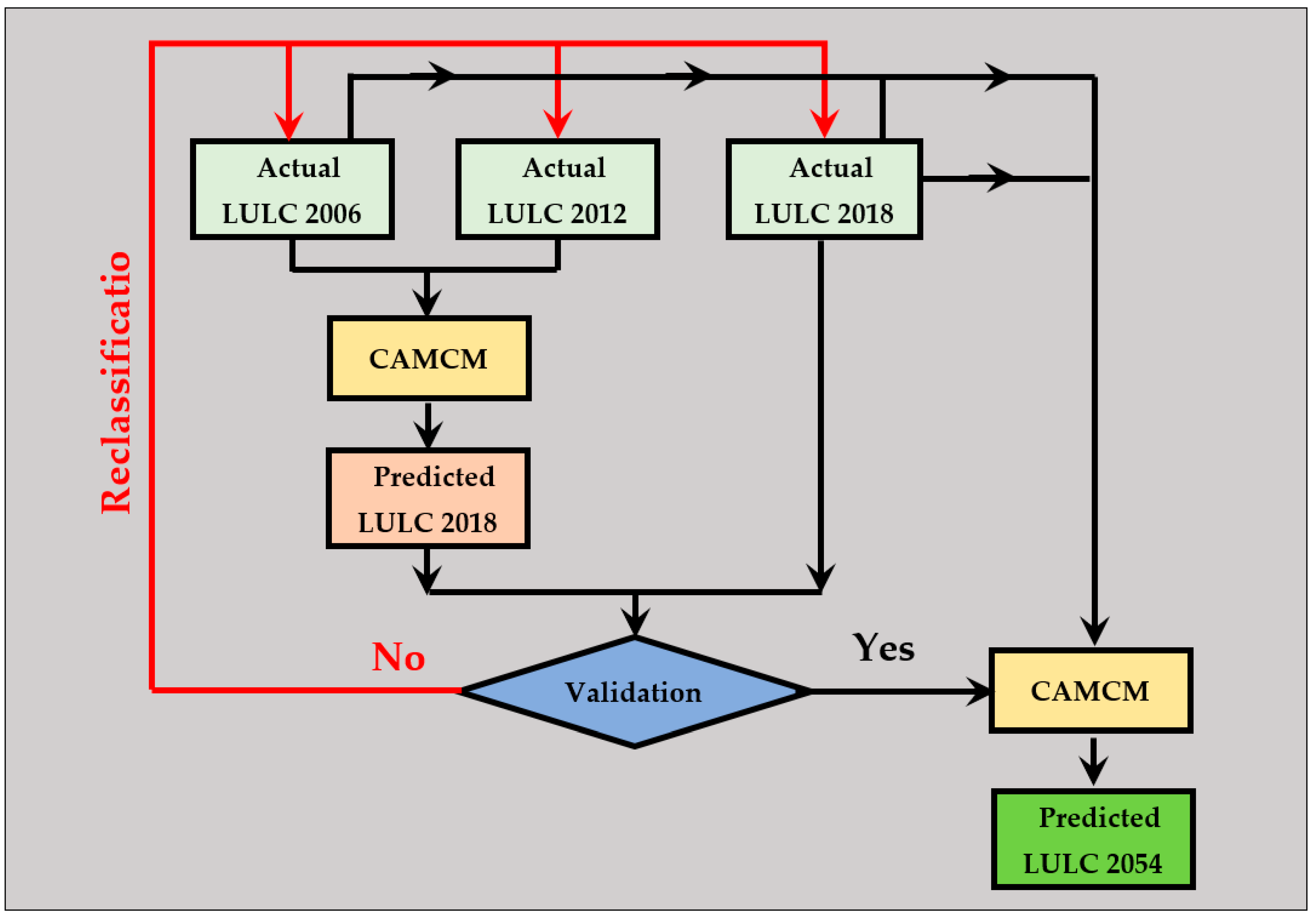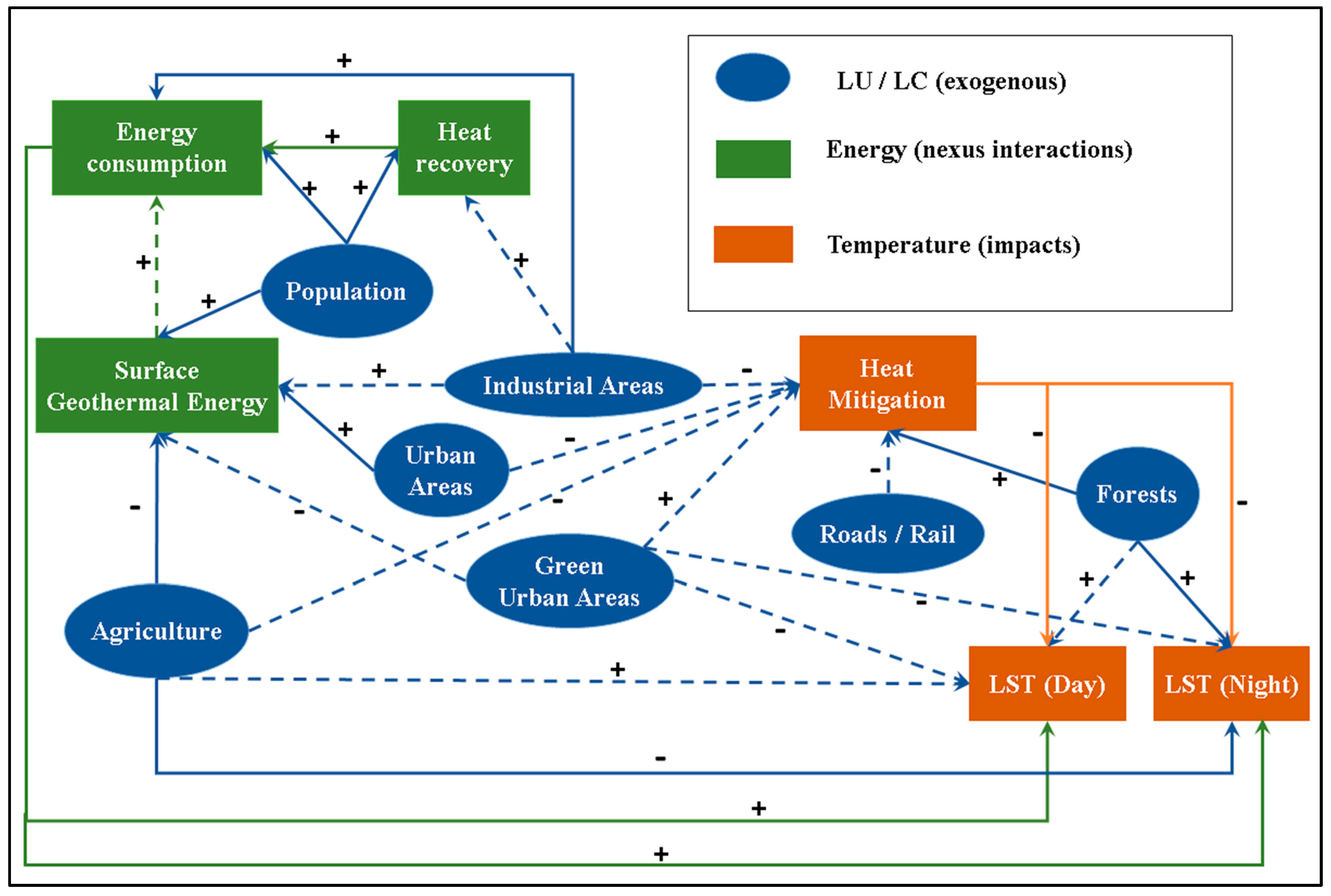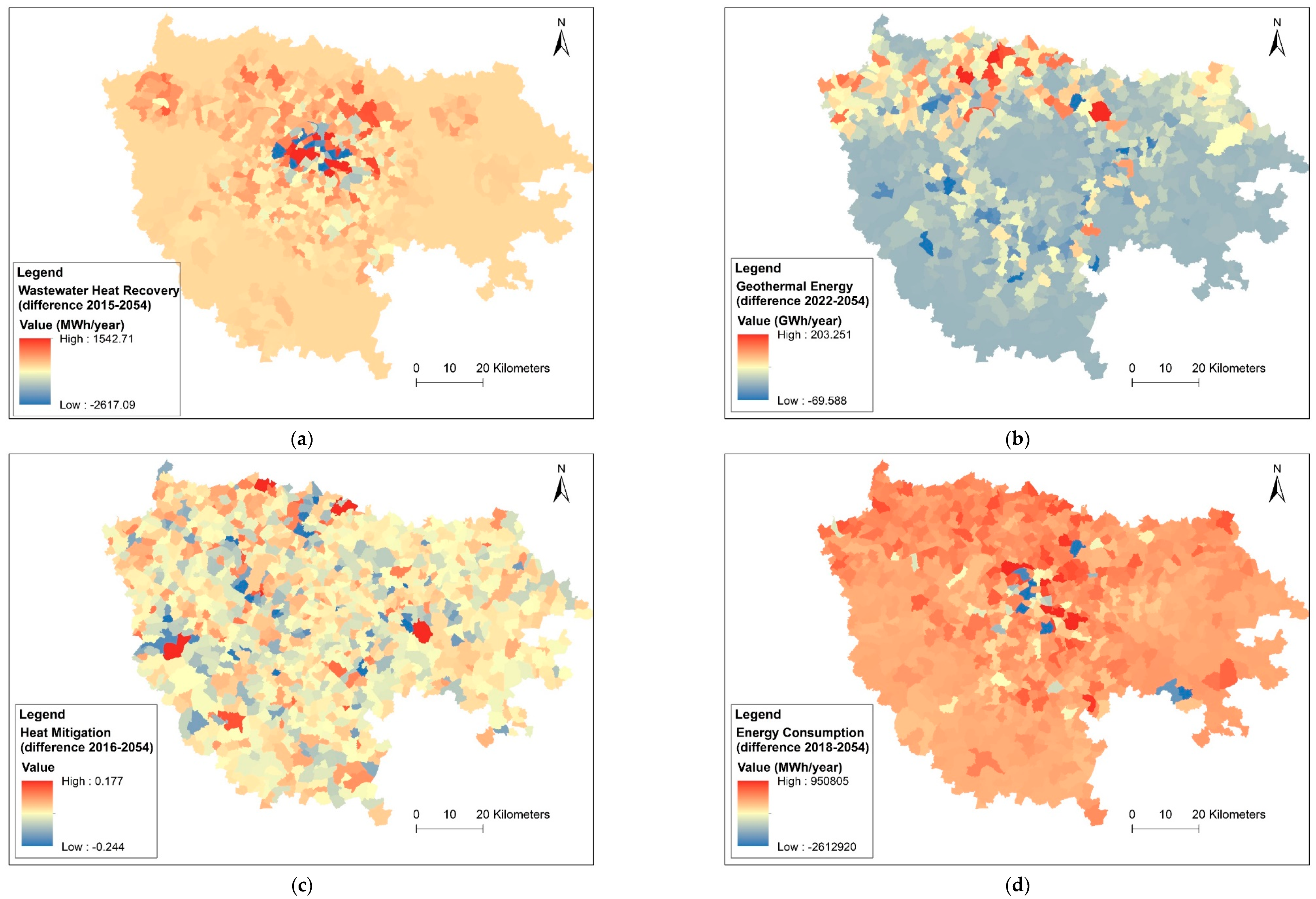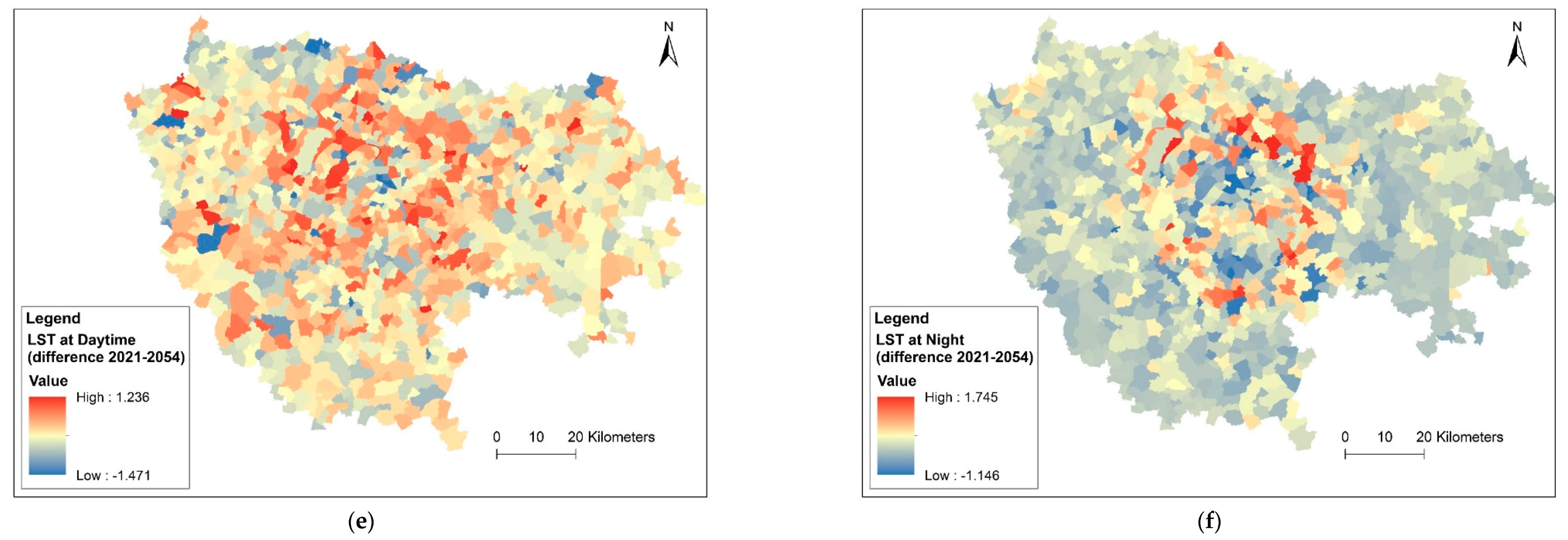1. Introduction
Due to rapid urbanization, European cities are encountering a lot of environmental, social, and economic challenges [
1]. The European Commission [
2] summarized these challenges as risk and disaster management, poverty and social equity, degradation of natural and green areas, degradation of water and air quality, impacts of urbanization on human health, climate change adaptation, provision of ecosystem services, cost-effective infrastructure (as the initial capital expenses and the cost of on-going operations represent about 3.8% of the global gross domestic product in the year 2013), and the sustainable development.
Nature-based solutions (NBS), as well as green and blue infrastructure (GBI), emerge as cost-effective solutions and answers for these challenges [
3] and will result in multiple benefits at the environmental and socioeconomic level, as well as for society and for public health [
2,
4]. These solutions, seeking sustainable development, could be implemented by harnessing the beneficial hidden sides of nature and infrastructure to turn socioeconomic and environmental challenges into innovative benefits and convenience. Despite the low number of research papers discussing the participation of stakeholders in NBS in Europe up to the year 2020 (e.g., 76 publications in all European countries; 5 in France), the European Union Research and Innovation (R&I) agenda on nature-based solutions pointed out that “
Europe will become a world leader both in R&I and in the growing market for nature-based solutions” [
1,
2]. To this end, understanding the effectiveness of these solutions is necessary before implementation; this requires a systemic approach that incorporates the technical measures’ regulatory, governing, financial, business, social, and geographical sides. In gross, the benefits can be depicted particularly in terms of: (a) exhaustive energy consumption (EC) and the questions of renewable sources of energy, (b) mitigation of heat and environmental risks, and (c) the economic burden of operating, protecting, and maintaining the traditional non-natural infrastructure, particularly for water drainage and management. More precisely, these solutions, considered to be urban innovations, stem from interactions between different domains such as: (i) soil–energy interactions, for instance, the geothermic production [
5,
6,
7]; (ii) wastewater–energy interactions, such as the fatal HR [
5,
8,
9]; (iii) green spaces–air temperature interactions: urban cooling, and enhancing air quality [
10,
11]; (iv) soil–water interactions: water management, flood mitigation, and water recharge [
12]; (v) soil–vegetation interactions: carbon storage [
10,
11], etc.
However, according to the scientific literature review, no systemic study has investigated all the possible interactions in the urban context, but only limited disciplinary approaches. Examples of these studies are those of NBS and GBI that focus on urban cooling and water management—the studies of local energy production (as fatal heat recovery (HR), geothermic production, and solar energy), and those examining the solutions to enhance air quality. Furthermore, almost all these solutions require space to be implemented, and this could lead to possible competition for space between these solutions. In addition, the existing territories are highly constrained by their histories, topographic specificities, and urban configurations: suggesting marginal evolution rather than a design from scratch. This spatial competition is also not well recognized or analyzed. The aforementioned spatial analysis is essential for decision support, especially when comparing the alternative solution in an integrated policy–science–society framework [
1]. This paper identifies the elements of three interacting spheres that are relevant to study urban innovations: (a) soil: the historical actor in urban development, space allocation, vegetation, imperviousness, albedo; (b) water: a crucial element necessary for life, but also a possible threat (storms, floods, etc.), stock and flow processes; and (c) energy: a crucial element, hard to produce in an urban setting, hard to store (batteries) and to transport over large distances. It is noteworthy to mention that both water and energy must be saved in the context of sustainable development. In the context of this research, all the solutions that cross at least two dimensions of the water–soil–energy nexus (WSE nexus) are envisioned. Attention must be drawn to the fact that NBS and GBI are part of the WSE nexus.
Figure 1 shows the most commonly known WSE interactions.
According to the literature review presented in the following subsection and to the best of the authors’ knowledge, the links between existing WSE solutions and urban characteristics, as well as the potential for further implementation of WSE solutions, are still unclear. As a result, these relationships are not well recognized and understood by institutional, political, and ruling authorities and official decision-makers, especially when they enact energy/environment-based policies. As a consequence, this could generate suboptimal sustainable development decisions.
Therefore, this paper aims to analyze the links between existing WSE solutions and urban characteristics in conjunction with the assessment of the potential for further implementation of WSE solutions in the Île-de-France area. This analysis aims to provide a clear picture of WSE solutions–urban interactions for the governing bodies and local authorities. Several hypotheses are proposed for validation. Among these suppositions, it is hypothesized that the dense urban areas (with high population density) represent good candidates for the implementation of wastewater HR solutions. In the same direction, medium to low urban areas are suggested to represent good candidates for the implementation of surface geothermic solutions. The hypotheses are also extended to assume that the implementation of some WSE solutions (notably HR) is attributed, in general, to political decisions rather than to factors from the urban context. Regarding limitations, this paper analyzes only the WSE nexus in the urban context and the potential of implementing these solutions from a spatial context, particularly the renewable energy sources and the WSE solutions to reduce the land surface temperature.
The solutions are designed to mitigate the risk of climate change, floods, and air pollution and to ensure that biodiversity protection is not investigated for further predictions. In particular, the impact of green roofs and vegetated facades on the quality and temperature of the air, as well as the effects of solar energy on fossil energy consumption, are not investigated due to limited available data and information about the explanatory variables. Several previous studies have investigated the different naturally and artificially established interactions between soil, water, energy, and vegetation. An overview of recent relevant studies is presented as follows. Various studies examined the effectiveness of operating different NBS (vegetation in particular) for better water management, ecosystem integrity, and biodiversity protection. For instance, Pander et al., Schindler et al., and Funk et al. [
13,
14,
15] examined the effects of reconnecting rivers to floodplains, by removing barriers along the river course in the Danube floodplain in Germany and in different countries of Europe on reducing the soil erosion, flood mitigation, and water purification. Similarly, the effects of green infrastructure, such as (i) reforestation, (ii) green roofs, (iii) maintaining vegetation cover and good soil structure, and (iv) the construction of shallow water bodies with vegetation, such as wetlands, on water management have been analyzed in the studies of Perni and Martínez-Paz in Spain [
16], Majidi et al. in Bangkok, Thailand [
17]; Soana et al. in Italy [
18], and Harrington et al. in Ireland [
19], respectively. Furthermore, the importance of green corridors and their associated drainage capacities in protecting the rail infrastructure, particularly in the case of extreme weather events, were examined by Blackwood et al. [
12]. In addition, the green infrastructures/infrastructure network, such as the green corridors, ensure the security of regional ecology by maintaining the ecosystem’s integrity and conserving biodiversity [
20,
21]. Other studies examined the cost efficacy of NBS, in the manner of afforestation, in supporting biodiversity and protecting the ecosystem services, such as in the study by Seddon et al. [
22], and in the vein of using high-albedo-pervious pavement material to slow down global warming and to mitigate heat and climate change as in the study of Majidi et al. [
17]. Similarly, Blackwood et al. [
12] explained how green corridors could support climate change adaptation and protect the transport infrastructure (e.g., rail services), specifically during extreme weather events.
Recent analyses were carried out to examine how to increase the sustainability of the use of matter and renewable energy [
23]. For instance, the HR from hot commercial, industrial, and domestic wastewater to reuse for residential heating demands, using technologies such as heat pumps and heat exchangers, was examined in different studies [
24,
25,
26]. Dürrenmatt and Wanner [
27] indicated that the process of HR is explained by two phases, (1) the thermal conductivity between the wastewater and the pipe wall, which temporarily store the heat, and (2) the recovery of energy by heat transfer from the wall of the pipe with the help of a heat exchanger and a heat pump. The wastewater HR process could be implemented at different scales as the wastewater treatment plants [
9,
28], the sewer network level, and the building level [
24]. The authors pointed out that the HR process could supply heat energy to individual buildings as well as to large communities. With a further detailed inspection, the wastewater treatment plants have a high potential to provide heat energy and feed urban areas, however, the efficiency of the system integration depends on the timeline grid of energy supply and demand as well as the spatial contiguity between the treatment plant and the beneficiaries [
9,
29]. On the other hand, surface geothermal energy (SGE) also represents a new way to reduce the consumption of fossil energy, particularly for home heating and cooling [
6,
7]. The SGE is used for air conditioning, such as cooling applications, as well as heating needs [
7]. The authors explained the setting up of the system as the deployment of a ground source heat pump system composed of a horizontal ground heat exchanger connected to a reversible geothermal heat pump that is connected to a chilled ceiling panel system.
In order to analyze the links between existing WSE solutions and urban characteristics of the surrounding areas as well as to predict the potential for future implementation of WSE solutions, the following summarized sequence is respected: (1) choosing a terrain: part of the Île-de-France region; (2) examining some implemented WSE solutions (e.g., HR from hot wastewater, SGE, forest development…); (3) characterizing the intensity (e.g., HR) or the effectiveness (e.g., heat mitigation (HM)) of the WSE solutions; (4) setting-up a statistical model (geographically weighted regression GWR) between the WSE characteristics and the urban characteristic (e.g., population, infrastructures…); (5) assessing the potential for further implementation of WSE solutions with the help of predictions for urban characteristics in the horizon of the year 2054; and (6) analyzing the possibilities for implementing the WSE solutions against the spatial demand represented by the need for this solutions. The year 2054 was selected (a) since it represents, from the current year, a sufficient time horizon to implement and evaluate the strategies proposed in this research, and (b) since the land use is projected for this year using the Cellular Automata Markov Chain Model (CAMCM) based on available data. With regards to GWR, these models are frequently used to link air temperature [
30] and the variation of the surface urban heat island [
31] to their influencing factors, such as the distance from water bodies and the vegetation cover. Nonetheless, and to the best of the author’s knowledge, there is no research study that employs the GWR in holistically examining the WSE nexus with its driving factors.
For the brief, this paper aims to (1) analyze the extensive (i.e., forestry development) and intensive (e.g., HR of wastewaters) components of WSE solutions, and (2) identify bottlenecks (e.g., saturation of urbanization in the north: forests are very unlikely to be developed there) and perspectives for the Greater Paris region. The paper is organized as follows. After the introduction, the second Section addresses the selection of the study area, the used research methodology and the data collection methods. The third Section presents the structure and the characteristics of the used models. The fourth Section summarizes and discusses the results and the fifth Section summarizes the main concluding remarks of the study and its limitations, and proposes new topics for future research.
2. Materials and Methods
Examining the possible benefits of implementing solutions from the WSE nexus, as the relationships that could be established between energy production and consumption, usage and management of water and soils, is the main focus of this study, which was undertaken as part of a larger research effort, the “Wise Cities” project. This project examines the potential benefits of implementing solutions in this area both from the technical and managerial sides. It focuses mainly on the relationships between water and soil and between water and energy. This Section consists of two parts: the first one refers to the selection of the study area, and the second part presents the adopted research methodology, the needed data, and the data collection technique. The study area, which covers the most developed urban zone of the Île-de-France region, extends over 9261 square kilometers. As the envisioned work presented in this paper is the assessment of several water–soil–energy solutions, such as the fatal HR and the recovery of SGE, the area of interest, which covers a large area of the Île-de-France region, was selected because different types of these solutions have been implemented there in several places [
5,
32,
33], and the required data are mostly available. The southeastern part of the Île-de-France region, which is outside the main agglomeration of Paris and for which the data are not available, is not included in the area of interest. Nonetheless, the study area is large enough to have proper data in order to be adopted to conduct the analysis. Regarding the analysis, the study area was selected to identify the key drivers of WSE solutions and to assess the possibility to predict their evolution. The predictions are envisioned for the horizon of the year 2054.
Figure 2 shows the area of interest.
The methodology consists of predicting and analyzing the potential changes in some essential elements of the water–soil–energy nexus, such as the SGE, as well as recovering heat energy from wastewater and afforestation/reforestation to assess the possibility of implementing these concepts, especially in high-demand areas. Applying these measures intends, in general, to reach sustainable development as the main objective. In a more detailed way, the objectives within the WSE nexus are depicted by (i) reducing the need for fossil energy by developing natural and recycled sources of energy, such as the SGE and the HR from hot wastewater, (ii) enhancing the use of renewable sources of energy, and (iii) reducing the land surface temperature and limit the emergence of the surface urban heat island phenomenon. In this perspective, the main factors to be examined are (i) EC, (ii) SGE, (iii) HR from wastewater, and (iv) the capacity for HM. To this end, the identification of explanatory variables, as well as the use of statistical and regression models as the correlation analysis, ordinary least squares (OLS), geographically weighted regressions (GWR), spatial autocorrelation, and variance analyses (ANOVA), could give an overview of the significant explanatory variables of dependent variables, their effect sizes, the possibility to calculate spatial regressions, and the possibility to predict the future changes/evolutions of these variables. At greater length, the identification of explanatory variables is conducted through logical reasoning of the common driving factors. The correlation analysis, which is the part that comes next and represents the first data filter, is used to refine the data by keeping only the representative variable and removing the remaining factors among the observed collinear variables.
The following step is the selection of the variables by conducting the second data refinement process presented by the ordinary least square regression model (OLS).
A particular variable can be modeled (or predicted) using the OLS, one of the general linear modeling techniques, if this variable can be explained (as a regressive dependence relationship) by other explanatory variables [
34] as indicated in the following equation:
where
β0, intercept;
βj, regression coefficients;
Xij, explanatory variables;
εi, random errors with mean 0 (uncorrelated with one another).
Different trials are conducted to check the best-performing OLS model by checking the adjusted coefficient of determination (R2), as well as the multi-collinearity of variables and the overall multi-collinearity of the model, in addition to the spatial distribution of the standard residuals and their z-scores. The spatial autocorrelation is used to measure the correlation among residuals caused by their spatial location [
35]. Usually, this test is used to check the existence of interactions between the residuals that are induced on the grounds of the spatial location of the observations. The spatial autocorrelation is a necessary measure to know whether the autocorrelation is significant or not. This latter concept could give information where the value of a residual is dependent or not on the values of neighboring residuals, so then the scale of the spatial dependence is determined by the geographic range within it the autocorrelation is significant. The following step is the application of the geographically weighted regression (GWR) in order to determine the regression relationship between the dependent variables and their explanatory variables, and also to establish a basis for the prediction process of future changes. The GWR is similar to the OLS model, however, the difference is depicted by taking the values of variables for each of the spatial features individually according to their spatial distribution. The GWR was developed as a solution for the problem indicating that the regression model estimated over an entire study area could not sufficiently cover local variations [
35]. A particular variable can be modeled (or predicted) at different spatial spots using the GWR model based in a dependence-regressive way on several explanatory variables following Equation (2).
where
ui and
vi, spatial coordinates of observation I;
β0, intercept at point (
ui,
vi);
βj, regression coefficients at point (
ui,
vi);
Xij, the explanatory variables at point (
ui,
vi);
εi, random error with mean 0.
The sequence of these processes, used to predict the changes in the dependent variables, is presented in
Figure 3.
Along the same lines and starting with the first part of identifying the possible explanatory variables, a structure of logical relationships is proposed to be analyzed. For instance, the wastewater HR and the SGE were hypothetically supposed to affect the EC in addition to the area of industrial land use and the demographic population. It is also hypothesized that the HR from wastewater is highly dependent on population and industrial areas where most of the hot wastewater is generated. It is also supposed that the SGE, which is usually implemented in the gardens of individual homes, is highly dependent on population and land use type. By way of explanation, the estate prices in industrial areas are usually less than in other urban zones. Moreover, the green areas were also supposed to affect the HM capacity of spatial zones, which could, in turn, affect the land surface temperature (LST) in addition to the consumption of energy and the areas of green zones.
Figure 4 shows a structure of relationships between the aforementioned factors.
Accordingly, the data of (i) population, (ii) land use/land cover (LULC), (iii) SGE, (iv) HM index, (v) EC, (vi) HR from hot wastewater, and (vii) LST index were collected from different sources. The data of population for the year 2017 were collected from the population database of INSEE (2021) website. The Urban Atlas [
36] provides the LULC maps for the Île-de-France area for the years 2006, 2012, and 2018. The data on wastewater heat recovery for the year 2015 indicates a concentric form of high capacities at the center with low capacity for the neighboring suburban areas. The potential of SGE available only for a small area in the Île-de-France region in the year 2022 was collected by digitizing the published distribution map of the
Bureau de Recherches Géologiques et Minières [
33]. In the same context, it is important to note that the data of SGE was extended by conducting a regressing projection of the ordinary least square (OLS) to cover the whole study area. The pattern of these data is mostly a ring and extends slightly to neighboring areas where the existence of many individual homes with private gardens where the SGE systems could be installed. The HM indexes for the Île-de-France region for the year 2016 were collected in a rasterized form from the Naturvation project [
10]. These values were aggregated, by average, to the community’s level. The pattern of these data follows that of the distribution of forests. The available data of EC for the year 2018, as well as that of HR from hot wastewater for the year 2015 in the Île-de-France region, were collected from the website of the Réseau d’Observation Statistique de l’Énergie [
5]. The EC pattern shows a downward radial trend of distribution from high values at the center to low values in peripheral areas. The land surface temperature indexes for the year 2021 were collected from the “Ilots de Chaleur Urbains” data provided by
Institut Paris Région [
37]. The texture of the distribution of LST indexes during daytime is almost the opposite of that of HM. Similar to the EC pattern, the distribution of LST indexes at night follows a downward path of distribution from high indexes in the center to low indexes at the fringes.
Figure 5 presents the maps of the collected data.
The LULC maps of the years 2006, 2012, and 2018 were used to predict the LULC for the year 2054 using the Cellular Automata Markov Chain Model (CAMCM). The time span of the prediction is 36 years and is commonly used in the scientific literature for LULC predictions mainly because 36 is a multiple of 12 (the period extended between the years 2006–2018) and because it constitutes a relatively long-term horizon. The first phase of this prediction process is the validation of the data used. This is conducted by (a) employing the available mapped data of 2006 and 2012 to predict the LULC for the year 2018 via the CAMCM simulations performed in TerrSet 18 software, and by (b) comparing the actual and predicted LULC maps for the year 2018. The prediction model was validated through Cohen’s kappa test conducted in TerrSet 18. The validation process showed high accuracy values of the predicted LULC for the year 2018. For instance, the calculated kappa values were all above 98%, indicating an almost perfect prediction according to Al-Shaar et al. [
38]. In detail, the kappa values were 0.9919 for “Kappa for no information (Kno)”, 0.9955 for “Kappa of grid cells level location (Klocation)”, 0.9999 for “Kappa of stratum level location (KlocationStrata)” and 0.9896 for the “Overall kappa (Kstandard)”. Subsequently, the LULC maps of the years 2006 and 2018 were the inputs to predict the LULC for the year 2054.
Figure 6 shows the process of predicting the LULC maps for the year 2054.
The changes of LULC between the years 2018 and 2054 showed (a) an increase of 5.52%, 17.7%, 1.25%, and 5%, respectively, in urban areas, industrial areas, forest, and wetlands, and the total area of roads and rail services; and (b) a decrease of 1.39%, 4.4%, and 50.9%, respectively, in the green urban areas, agriculture lands and bare soil zones. The land use/land cover distributions for the years 2018 and 2054 are presented in
Figure A1 and
Figure A2 in
Appendix A. The population data for the year 2054 were calculated based on the forecasts in Île-de-France, which were prepared by INSEE [
39]. The population in Île-de-France for the year 2013 was 11,959,800 persons [
39]. These forecasts show that the population in Île-de-France in the year 2050 will be 13,504,900 persons. A simple projection for the year 2054 was conducted and indicated a population size of 13,689,488 persons.
The population growth amounts in the study area communities are considered proportional to the urban growth rate in each community indicated by the predicted LULC distribution for the year 2054. Accordingly, the changes in population density between the years 2017 and 2054 show strong population growth in the North and Northeast of the study area. These changes are presented in
Figure 7.
The current and projected data (to the year 2054) of population and LULC distributions are used in the statistical models, especially the GWR and ANOVA, to predict the evolution of SGE, hot wastewater HR and EC as well HM index, in addition to land surface temperature index.
5. Conclusions
This paper investigates the trends and the solutions to manage the water–soil–energy nexus in the context of increasing urbanization. The examined solutions, integrated into the water–soil–energy nexus, are designed primarily to reduce the consumption of fossil energy by discovering and implementing new renewable sources of energy and for heat mitigation by examining the spatial possibilities for afforestation/reforestation. However, the effects of exogenous spatial driving factors of these solutions, in addition to their future spatial evolution are not holistically studied. Bearing in mind the spatial competition between different land use/land cover patterns, the analysis is elaborated by (a) determining the areas with low, medium, and high potential for implementing the solutions, as well as defining the type of solution to be implemented, and (b) by comparing the aforementioned implementation capacities with the demand depicted as the needs for slowing down the effects of the surface urban heat islands and warming, and reducing dependence on fossil energy. This study identifies the current key drivers of the SGE, the wastewater HR and the spatial capacity for HM in the study area, which covers a wide spatial extent in the Île-de-France region, in addition to their potential spatial changes until the year 2054. This methodology used the statistical analysis of OLS and GWR, combined with the geographic information system, based on data on land use/land cover as well as the distribution of population. The findings indicate that the spatial autocorrelation of GWR residuals is lesser than those of OLS models. The difference, introduced as the ratios, ranges from 1.33 to 11.44. These values are clearly observed particularly in the cases of SGE (11.44) and HM (10.55). On that account, GWR models explain the regressive relationships between key drivers and WSE solutions at the individual spatial level. In addition, these models predict the spatial evolution of the examined WSE solutions. In addition, variance analyses were conducted to quantify the influence of each driving factor. For instance, and with respect to LST, the key determinants change over the daytime. Whereas the HM and the EC are the main determining factors for daytime LST with effect sizes of 85.66% and 8.20%, respectively, the nighttime LST is affected by HM and EC in addition to the existence of agriculture areas and forests with effect sizes of 22.84%, 35.38%, 31.6%, and 8.93%, respectively. This change needs to be further investigated to identify the reasons behind it since the effects of determining factors support the selection of solutions and plans as well as supporting and guiding the enactment of corresponding policies. Regarding the prediction results, areas with the potential for implementing specific solutions are determined and classified according to their capacities. Along the same lines, these capacities are compared to the demand for reducing the dependence on fossil energy and slowing down the effects of surface urban heat islands. The predictions indicate three types of distribution regarding the energy consumption: (i) the best fit where the potential for implementing SGE or HR is elevated and associated with an increase in energy consumption as in the northern part of areas surrounding the center of Île-de-France, (ii) the medium pattern where the potential for implementing SGE or HR is elevated, however, the energy consumption is expected to decrease as in some area of Paris, and (iii) the worst case where the potential for implementing SGE or HR is low/null and the energy consumption is expected to increase as in the southwest and southeast parts of the central zone and its neighboring areas. With respect to the predicted change of HM capacities between the years 2016 and 2054, it is important to mention that in some areas the forecasted reduced capacities of HM are not associated with human activities. The reasons behind this change should be clarified by further research. Concerning the limitations, the solutions designed (a) to mitigate the risk of climate change, floods, air pollution, and temperature, (b) to protect biodiversity, and (c) to reduce the dependence on fossil energy, such as the green roofs and vegetated facades as well as the solar energy, were not inspected due to limited data and information about the explanatory variables.
Moreover, the impacts of air temperature on the consumption of fossil energy were not investigated. It would be interesting to clarify all these points in further research.
